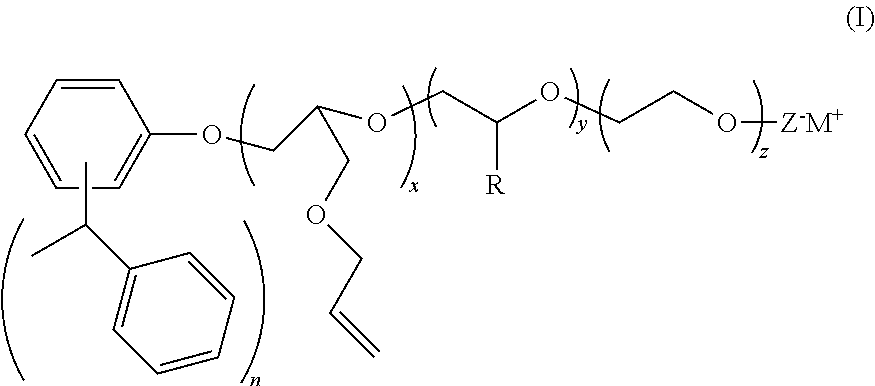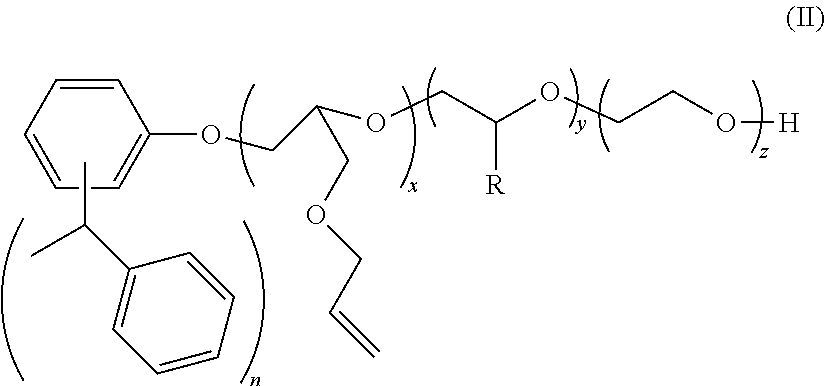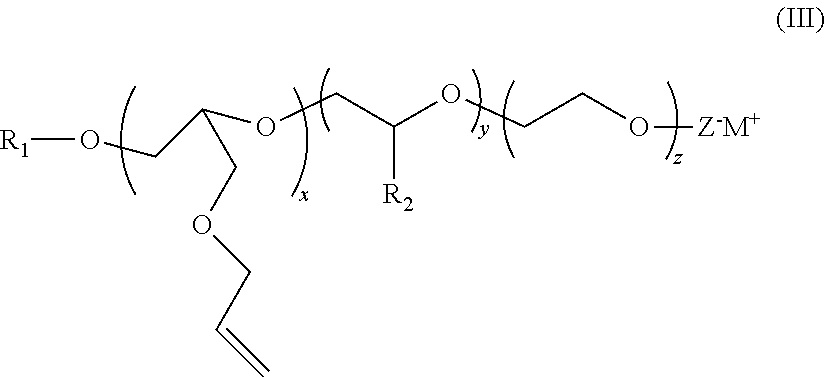New reactive surfactants for freeze-thaw stable emulsion polymers and coatings thereof
a surfactant and freeze-thaw stable technology, applied in the field of freeze-thaw stable emulsions, can solve the problems of product sensitive to water, many compounds that would theoretically be useful are not useful, and the emulsifier cannot be completely removed from the latex, so as to improve the stability of freeze-thaw, improve the water repellency, and reduce the effect of particle siz
- Summary
- Abstract
- Description
- Claims
- Application Information
AI Technical Summary
Benefits of technology
Problems solved by technology
Method used
Image
Examples
example 1
[0063]Distyrenated phenol (DSP) (694 g, 1 equivalent) was added to a stainless steel autoclave along with allyl glycidyl ether (AGE) (494 g, 2 equivalents) and potassium hydroxide KOH (2.3 g) and the autoclave sealed and heated to 105 C. When all of the AGE was consumed, the reaction mass was cooled, and the product discharged. This is AGE 2 DSP adduct.
[0064]1680 g of this AGE 2 DSP adduct (1 equivalent) was added to another autoclave and heated to 105 C. Ethylene oxide (2026 g, 15 equivalents) was then added over the course of several hours. After all of the EO was consumed, the reaction mass was cooled and the catalyst neutralized with the addition of a small amount of acid. This material is Example 1. This material is also referred to as ERS 1617. This material is also known as ERS 1617.
example 1a
[0065]Distyrenated phenol (DSP) (1388 g, 2 equivalent) was added to a stainless steel autoclave along with allyl glycidyl ether (AGE) (988 g, 4 equivalents) and potassium hydroxide KOH (4.6 g) and the autoclave sealed and heated to 105 C. When all of the AGE was consumed, the reaction mass was cooled, and the product discharged. This is AGE 2 DSP adduct.
[0066]3360 g of this AGE 2 DSP adduct (2 equivalents) was added to another autoclave and heated to 105 C. Ethylene oxide (4052 g, 30 equivalents) was then added over the course of several hours. After all of the EO was consumed, the reaction mass was cooled and the catalyst neutralized with the addition of a small amount of acid.
example 1b
[0067]Distyrenated phenol (DSP) (347 g, 0.5 equivalent) was added to a stainless steel autoclave along with allyl glycidyl ether (AGE) (247 g, 1 equivalents) and potassium hydroxide KOH (1.15 g) and the autoclave sealed and heated to 105 C. When all of the AGE was consumed, the reaction mass was cooled, and the product discharged. This is AGE 2 DSP adduct.
[0068]940 g of this AGE 2 DSP adduct (0.5 equivalent) was added to another autoclave and heated to 105 C. Ethylene oxide (1013 g, 7.5 equivalents) was then added over the course of several hours. After all of the EO was consumed, the reaction mass was cooled and the catalyst neutralized with the addition of a small amount of acid.
PUM
| Property | Measurement | Unit |
|---|---|---|
| size | aaaaa | aaaaa |
| stability | aaaaa | aaaaa |
| freeze-thaw stability | aaaaa | aaaaa |
Abstract
Description
Claims
Application Information
 Login to View More
Login to View More - R&D
- Intellectual Property
- Life Sciences
- Materials
- Tech Scout
- Unparalleled Data Quality
- Higher Quality Content
- 60% Fewer Hallucinations
Browse by: Latest US Patents, China's latest patents, Technical Efficacy Thesaurus, Application Domain, Technology Topic, Popular Technical Reports.
© 2025 PatSnap. All rights reserved.Legal|Privacy policy|Modern Slavery Act Transparency Statement|Sitemap|About US| Contact US: help@patsnap.com



